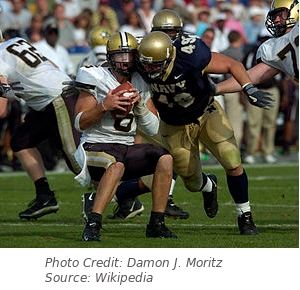 In October 2009, the House Judiciary Committee held a contentious hearing on the NFL’s response to brain injuries in current and former players. The chairman of the NFL committee on brain injuries subsequently resigned. In December 2009, the NFL announced stricter guidelines for returning to play after a player sustains a concussion on the field.
In October 2009, the House Judiciary Committee held a contentious hearing on the NFL’s response to brain injuries in current and former players. The chairman of the NFL committee on brain injuries subsequently resigned. In December 2009, the NFL announced stricter guidelines for returning to play after a player sustains a concussion on the field.
The new guidelines require that players who suffer concussions cannot return to a game or practice until they show no further symptoms of concussion and are cleared by both the team doctor and an independent neurologist.
Under the old guidelines, players commonly returned to play on the same day if they were no longer showing symptoms of concussion, but without a full neurological evaluation. A second blow to the head of an already-concussed player has the potential to cause severe brain damage.
The NFL has joined forces with Boston University to research the effects of concussions on football players. The university research group recently conducted post-mortem analysis of several former NFL and college players. Their analysis has led to the diagnosis of chronic traumatic encephalopathy, a degenerative disease caused by concussions, in Lou Creekmur (eight-time Pro Bowler and Former Detroit Lions lineman), John Grimsley (former Houston Oilers and Miami Dolphins linebacker), and Tom McHale (former Tampa Bay Buccaneers guard).
Team doctors, who owe a duty of care to the players as their patients, are also under pressure from the team that employs them to return players to the field quickly. Merrill Hoge, a former Chicago Bears running back, won a jury verdict of $1.55 million in 2000 against a former team physician who was alleged to have mishandled Hoge’s concussion. That case was later settled for an undisclosed amount.
Brain injuries are a growing issue for the NFL in the area of workers’ compensation. Ralph Wenzel, a former NFL lineman has filed a workers’ compensation claim in California citing dementia as a result of brain injuries on the field. One recent study has indicated that former players have rates of memory-related diseases that are between 5 and 19 times the rate of the general population. The New York Times points out that California is the main state in which former players file for workers’ compensation due to workers’ compensation laws that allow workers to file based on the date they were informed of their rights by their employers instead of based on the date of the injury, as well as a rule that allows former players to file for cumulative injuries after playing only one game in California.
The new concussion policy has impacted NFL play already this year, notably in the case of the Chicago Bears’ Jay Cutler, who suffered a concussion in the October 4th game against the New York Giants. Under the old rules, Cutler may have been allowed to return to field during the same game, as he did not lose consciousness.
NFL football is a violent sport. Concussions will undoubtedly always be a part of the game. The NFL’s new concussion guidelines are simply a first step in protecting players, and not coincidentally, reducing the liability of team doctors and the league’s workers’ compensation insurance premiums.
